StoryFit’s Script Analysis Breaks Down Famous Screenplays
Posted: April 11, 2023 | Updated: April 20, 2023
Posted In: Articles
We used our AI script analysis engine to analyze recent award-winning screenplays to uncover what made them a hit.
Was it the story structure? Or maybe the unique character development or character arc? How about the tonal themes and emotional resonance? Perhaps a combination of all three?
We’ll get into more detail below about what made these stories tick.
Screenplays are the blueprints for the films we love. Often celebrated for their ability to captivate audiences, provoke thought, and evoke emotion in real life, they are the backbone for every great movie or show. Actors, directors, and producers contribute their own perspectives on how the overall message of a story should be presented to audiences, but the screenplay serves as the foundation for the rest of the action, dialogue, character journey, and text work that we see on the big screen.
Every year, the film industry recognizes exceptional screenplays through various awards ceremonies, like the Academy Awards, the Writers Guild of America, and the Golden Globes. These award shows are not just a celebration of the talented performances of an actor, the unique interpretations of a director, or the interesting ideas of a writer. They recognize the intricate components that make up a great screenplay, beginning to end.
In this article, we will apply StoryFit’s AI script analysis findings to talk about what makes award-recognized screenplays so interesting to audiences, breaking down their key elements and analyzing their story strengths. By examining the nuances of these acclaimed scripts in more detail, we can gain a deeper understanding of what sets them apart from the rest, and perhaps even learn a thing or two about the craft of screenwriting from script analysis.
How does StoryFit’s script analysis work?
At StoryFit, we use proprietary AI technology built off of hundreds of models to measure thousands of story components at the same time. Scripts are ingested in our AI engine and are measured against the thousands of other scripts we have within our database to analyze where it indexes in its intended genre (drama, comedy, action, and thriller to name a few).
Not only does this script analysis deliver interesting findings about the overall strength of an idea or story, it accounts for all components of a script: the plot, the characters, the tone, the dialogue, and even emotional resonance to predict how audiences might respond. All of this data helps us see the true value in a script so writers, creators, or executives can get a better understanding of how it will do and what their next steps are to ensure its a box office success.
Navigating an ever-changing entertainment industry
Predicting script success has never been an easy task for filmmakers, producers, or investors. This is due in large part to the constantly evolving nature of the entertainment industry. Trends come and go, audience tastes shift, and what was once popular may no longer resonate with viewers. Furthermore, there are numerous factors that can affect a film’s success, including marketing, budgeting, and external circumstances that inhibit audience enjoyment. All of these variables make it challenging to accurately predict which scripts will ultimately translate into box office success. However, StoryFit’s AI technology begins to change that.
With the help of script analysis, the process of predicting a script’s potential success becomes highly sophisticated yet possible task. AI algorithms can analyze vast amounts of data on audience preferences, past box office performance, and successful genre and character trends to make more informed predictions backed by objective data points (rather than an individual’s own interpretation or reading of a script).
While it is still a fairly new process, it already aids in large-scale decision-making and works to mitigate some of the inherent uncertainties of the industry. The ability to analyze multiple scripts in an automated way is revolutionary and holds the potential to thoroughly change the way we think about, respond to, and appreciate the intricacies of great storytelling.
The Elements of Success: Why these award-recognized screenplays worked
The 2023 best picture nominees include a diverse range of films, from powerful character-driven dramas to visually stunning blockbusters.
Despite their differences in genre and style, these films share a common thread: exceptional screenplays. Whether through intricate plots or emotionally resonant themes, each film connected with audiences on a deeper level, leaving a lasting impact long after the credits rolled.
So what are these fundamental elements to the success of a story, and how do you know whether or not they are working?
StoryFit’s script analysis is the perfect way to get to some of these answers.
Story
1. At the heart of any great screenplay is a compelling story.
Award-winning screenplays often have a unique take on a familiar tale, or they explore complex themes and ideas that outpace or exceed that of their competitors. For instance, any script can depict a failed friendship, but not just any script can deliver it in a way that applies specific narrative themes with comedic and thought-provoking underlays to grab the audience’s attention quite like the Banshees of Inisherin did.
We had our AI analyze this award-winning screenplay to see how it ranked within the genre, but also in comparison to director Martin McDonagh’s other notable films like In Bruges (2008) and Three Billboards Outside Ebbing Missouri (2017).
It’s no secret that McDonagh’s films are characteristically dark, but they almost always incorporate other accompanying comedic and satirical tones to underlay the characters objectives. For example, when we look at Three Billboards compared to other Drama films, it lands in the top 10% for Dry Humor, while In Bruges lands in the top 25% for Crude Humor. The Banshees of Inisherin is notably Absurd, and this sets the movie apart from other Comedy Dramas.
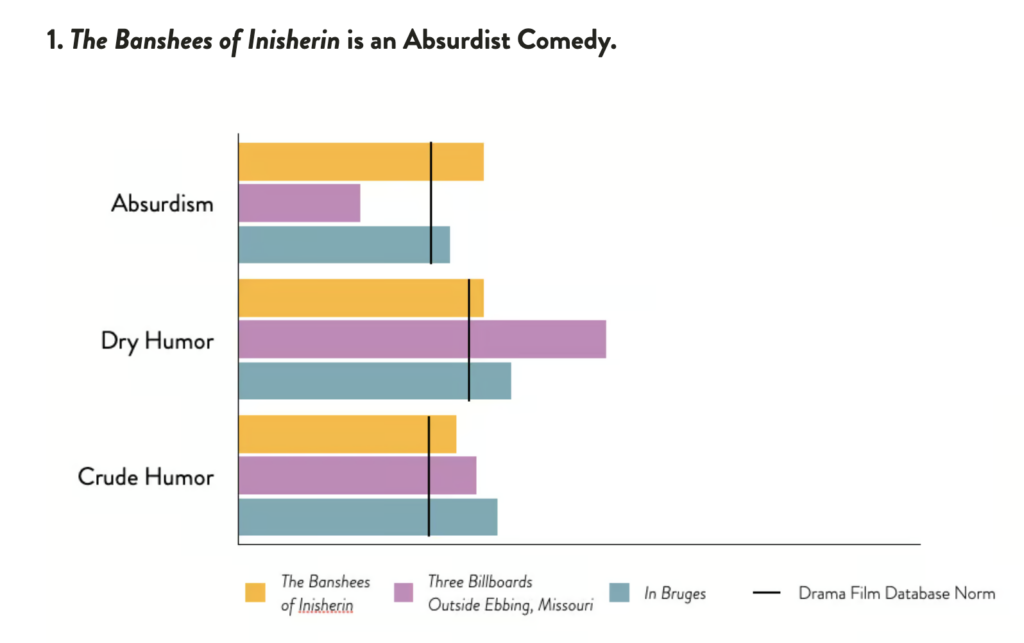
Compared to other Drama films in our database, The Banshees of Inisherin script was in the top 10% (what we call reaching the “impact level”) for the following cinematic tones: Unsettling, Disturbing, and Eerie.
It was located in the top 25% (“prominent level”) for Thought-Provoking, Stressful, and Anxiety. These narrative elements speak to how masterfully McDonagh weaves the gripping and tenuous relationship between Padraic and Colm among the more isolated, striking Irish atmosphere.
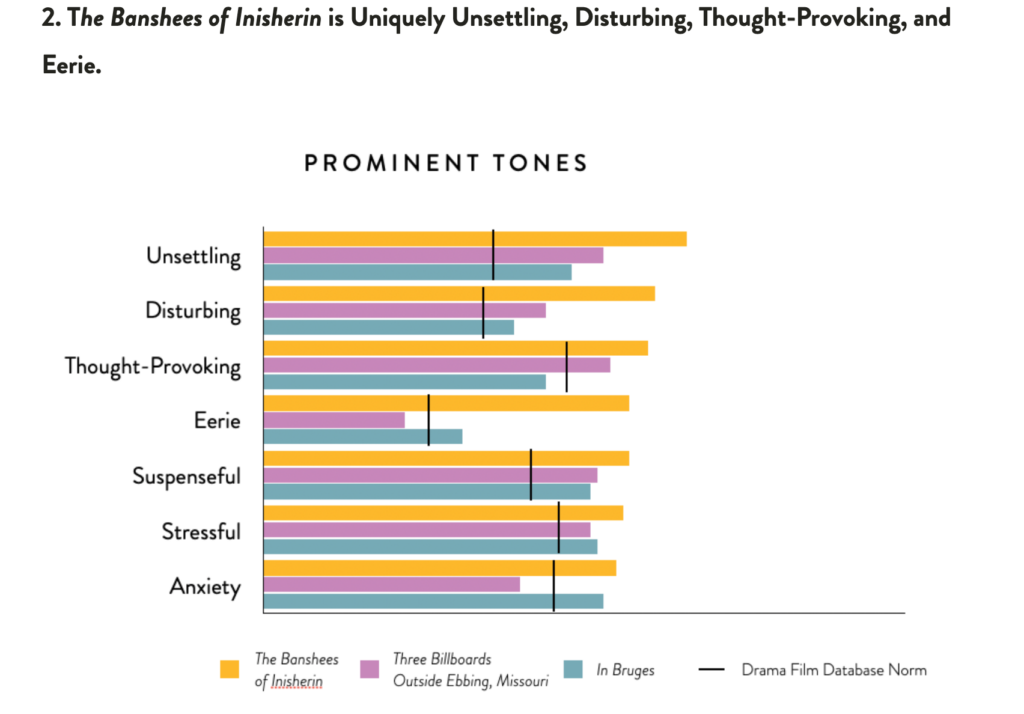
Banshees is also McDonagh’s most violent film to date. Our script analysis picked up significant moments weaved within the screenplay to heighten the emotional intrigue of the narrative and leave viewers with an experience they don’t often see from a comedy.
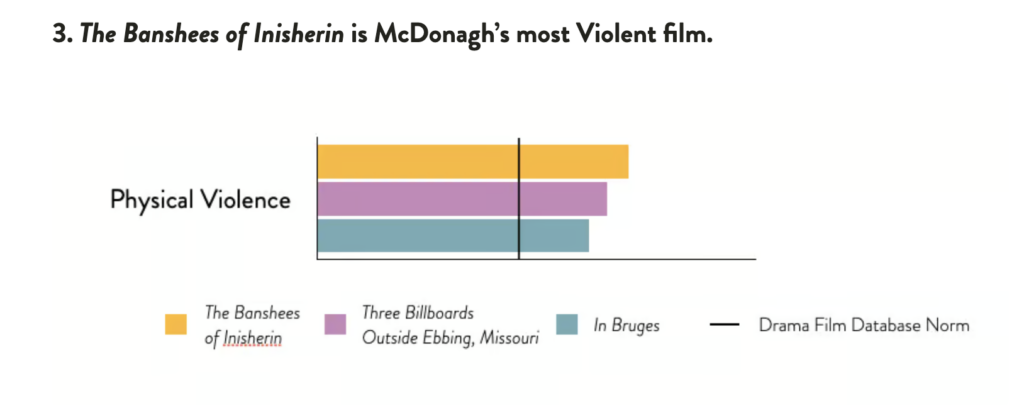
Characters
2. Strong characters make or break the story.
Award-winning screenplays often feature complex, multi-dimensional characters that the audience can relate to and empathize with. These characters have clear motivations, distinct personalities, and dynamic character arcs.
One key component that many of these films share is their ability to create complex, fully realized characters that audiences can see pieces of themselves in. Some of the strongest, most compelling characters to audiences are the ones written to be flawed. This allows for more nuanced storytelling, as their motivations and actions are not easily predictable and they act or react on impulse rather than prior planning. You can learn more about character analysis and the ways that AI enriches character development here.
Here’s just a few of the character traits our AI script analysis engine registers when evaluating a strong lead or supporting character:
- Anxious
- Heroic
- Greedy
- Likable
- Thought-Provoking
- Narcissistic
- Keeps Promises
- Altruistic
- Multi-Dimensional
Like we mentioned earlier, strong characters are the foundation of good stories. Our platform analyzes each character in a script to give them a score based on a combination of their prominent and impact level traits (traits that they index in the top 10% and 25% of for all characters within the genre). This score is an overall indicator of a character’s potential, as it measures the strong and defining character traits an audience will recognize. A higher score is always better, as this character assessment correlates to the success of a series.
The main character of the Oscar-nominated movie script, Living is no exception. His character’s objective is defined by bold, clever, competent, and methodical actions, and audiences see Williams as an interesting, multi-dimensional and thought provoking lead (the golden trio of traits!). Our AI registered him just below the “iconic” level for character score.
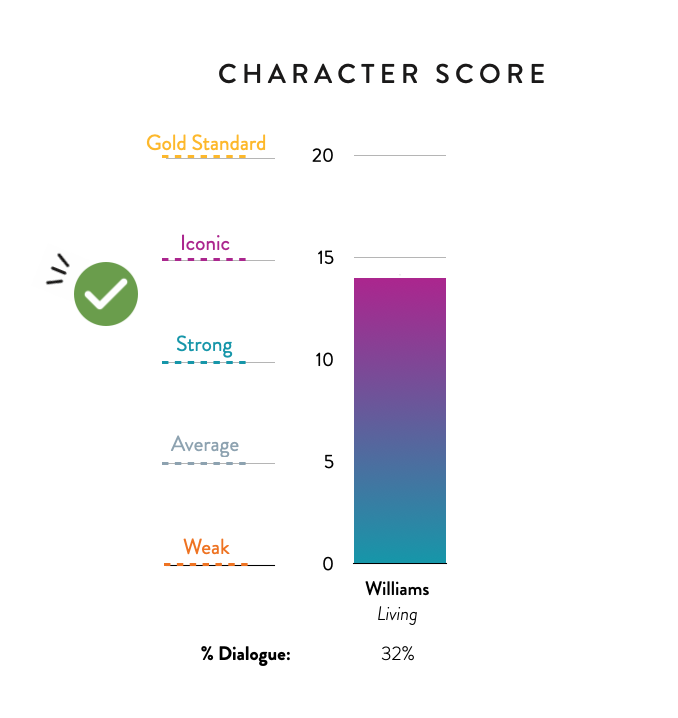
Dialogue and Character Relationships
3. Dynamic dialogue defines your characters.
Successful screenplays feature dialogue that is natural and engaging, and that advances the story and reveals character intentions and morality. The dialogue should be memorable and impactful to audiences, but also inherently believable to the character and their goals.
Dialogue is one of the primary ways in which characters are developed and their relationships are established. Through dialogue, audiences gain insight into a character’s personality, motivations, and internal conflicts in a particular scene. It can also reveal the subtext of a scene, allowing the audience to interpret what isn’t explicitly being stated to propel the plot and tone of a particular moment for other characters. Effective dialogue is inherently tied to believability, which is why character relationships are so crucial to any screenplay.
StoryFit’s Character Network is an elaborate visual mapping process designed to analyze this very component. From this network, we can visualize and also quantify the following:
- # of major characters (any character is considered “major” with 10% or more of dialogue as marked in the script)
- # of supporting characters (between 4% and 9% of dialogue)
- # of minor characters (3% or less of dialogue)
- Centrality, which measures the percentage of shared interactions between characters. A lead with a high level of centrality is more likely to be considered strong
- % of scenes a character appears in vs. % of scenes they speak in
- Characters that interact the most together – a sufficient way to determine important relationships to the script and identify if they are aligned with the writer’s intentions
Here is the character network breakdown of the Academy Award winning film, Everything Everywhere All At Once.
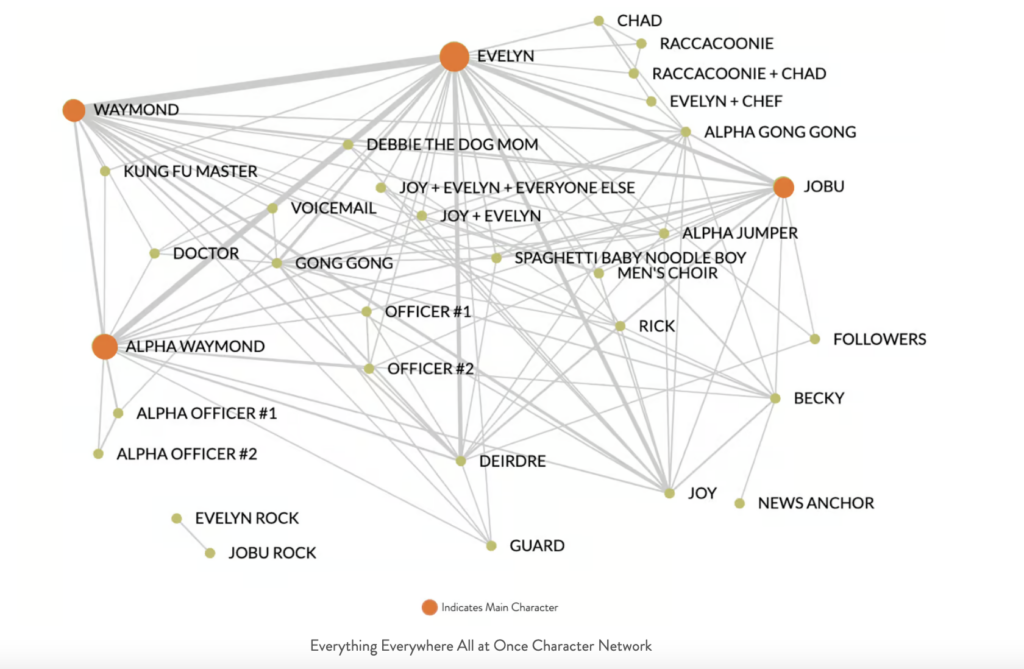
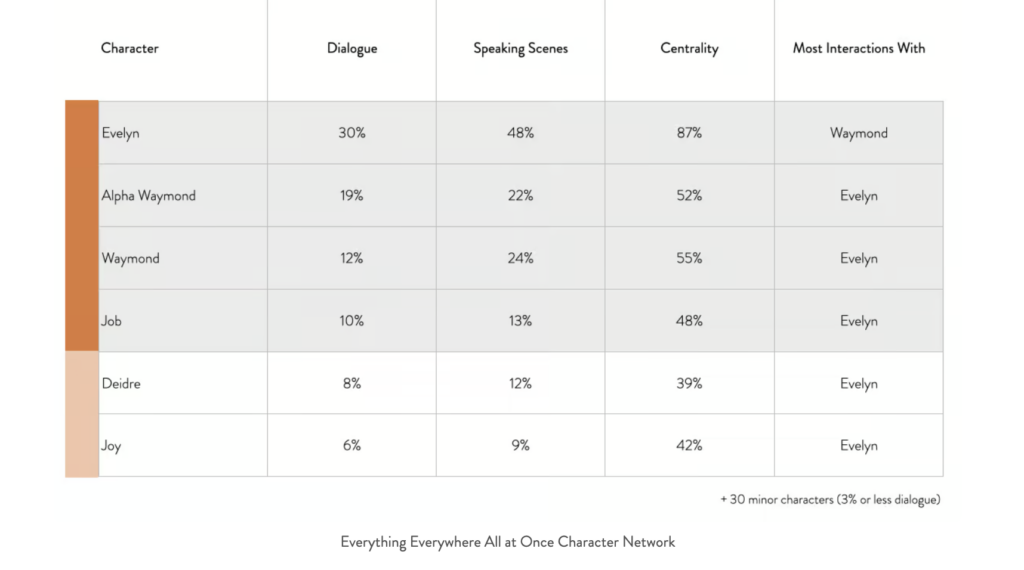
We can see that although Everything Everyone All at Once boasts a sprawling and complex narrative, family dynamics are at the heart of the story.
Evelyn is the protagonist at the center, and her emotionally intense relationships with her husband Waymond and daughter Jobu propel the narrative action. This is a great example of the difference a scene partner can make in a story.
Structure & Tone
4. If the audience isn’t invested in the story, what’s the point?
Structure is the backbone of any great story, whether it’s an all encompassing novel, film, show, or even bedtime tale. Successful screenplays often have a clearly structured act breakdown, with a well-defined beginning, middle, and end. Analyzing the level of emotional intensity in each act is a useful way of judging the tonal significance of the story. Screenplays with a high level of emotional intensity (referring to the level of emotional response from a viewer) are guaranteed to garner more engagement and interest from audiences.
Keep in mind, emotionally intense screenplays often have many peaks and valleys – moments that spike above and below what we call the “presence threshold,” referring to the level of viewer awareness throughout all the lines, various scenes, and beat changes. Rises and falls in emotional intensity adds to the overall suspense and audience investment in a particular story, which works to create tension throughout.
Let’s take a look at two movies that do this exceptionally well: the 2023 Best Picture Academy Award winner, Everything Everywhere All At Once and 2020’s winner, Parasite.
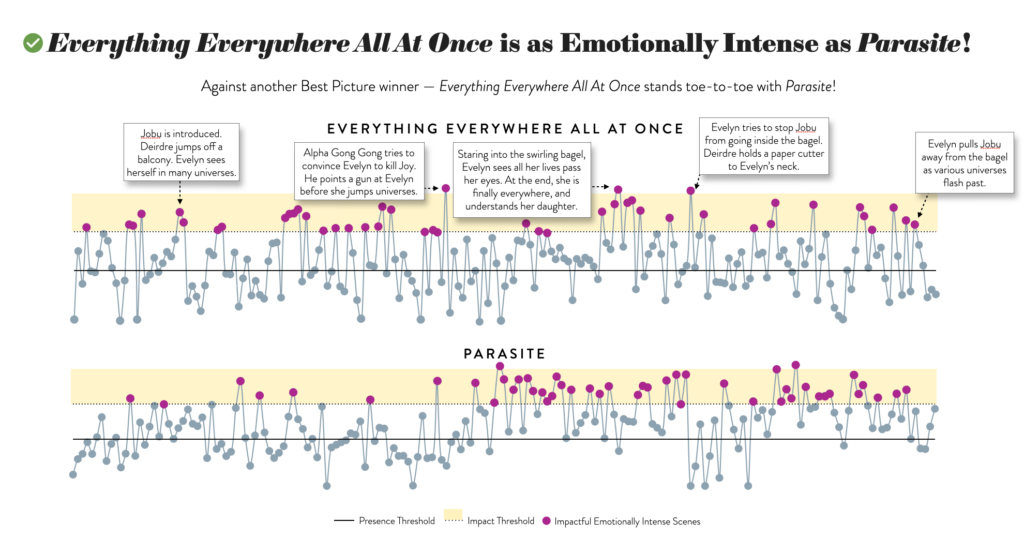
Both films have numerous moments of emotionally intense scenes that register at the impact level throughout. Where Parasite mostly spikes in the second and third act, Everything Everywhere is consistently engaging. The film is regarded as a standout among critics and audiences alike, and we can see this demonstrated throughout our AI script analysis. To learn more about the additional ways it breaks the genre mold, give this deep dive a close reading to learn more about the intended meaning behind the film.
When judging an award-winning screenplay, it’s important to consider all of these factors, as no component alone makes for a great story or script. It’s the intersection and application of all of these elements together that elicits success. Audiences love when stories offer a unique and engaging story that resonates with them on a deeper level.
These screenplays offer insights into the human condition, explore complex ideas, and present a fresh perspective on familiar themes for their given circumstances. By examining the key components of story, character, dialogue, and tone, we can gain a deeper appreciation for what makes these screenplays tick, and why audiences love to keep watching them.
